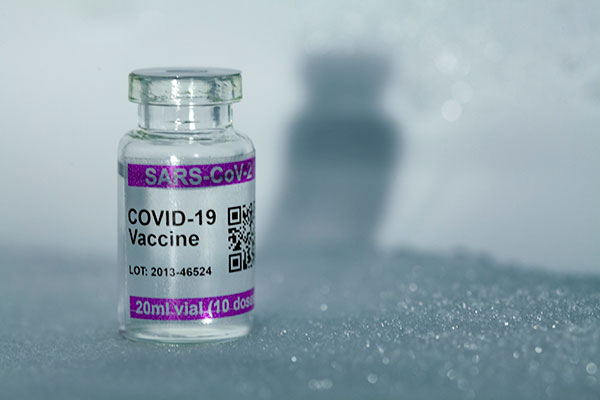Dry ice is a critical supply chain component of COVID-19 vaccine distribution efforts

Did anyone really think a year ago at this time that a major theme in logistics would be the importance of dry ice? It is reasonably safe to assume that the short answer is: “no.”
Well, that has clearly changed now, given that dry ice is, and will continue to be, a key factor in keeping doses of many COVID-19 vaccinations at the required temperatures needed, in order for them to be effective. For example, the Pfizer vaccine needs to be kept at -70 Celsius.
Evan Armstrong, president of Milwaukee-based supply chain consultancy Armstrong & Associates recently pointed out to me that securing the needed quantity of dry ice has been a problem, due to the decline in oil prices, going back to the onset of the pandemic.
“Dry ice manufacturing happens next to oil refinery plants, because they capture the CO2 out of the process,” Armstrong explained. “When the price of oil dropped, it really created a lot less C02 and because the production went down, it impacted it…and right now dry ice supplies are very tight.”
And the challenges related to limited dry ice availability are likely to continue, with Pfizer needing its vaccine to be at -70 Celsius, with the end effect being a likely crimp that will impact other verticals.
“What is going to happen is as the Pfizer vaccine needs to get distributed at -70C, all of the dry ice is going to get sucked up for vaccine distribution or healthcare related activities and it is just sitting there now,” he said. “That is going to impact all of the food and grocery stuff that happens on the frozen side, so the ripple effects of that are going to be pretty extreme, when it comes to all of the distribution of non-healthcare products that require dry ice as well.”
A MarketWatch report highlighted other related challenges of dry ice-related vaccine distribution, pointing to the safety concerns related to transporting of dry ice that can emit CO2 on airplanes.
“Packaging dry ice in a container that does not allow adequate release of the gas could cause the container to explode from the built-up levels of pressure, a process known as sublimation,” the report stated. “Dry ice can also deprive a confined space of oxygen, making it difficult to breathe. That’s why the U.S. Department of Transportation and the International Air Transport Association classify dry ice as hazardous when transported. Though under normal flight ventilation conditions, the risk of suffocation or an explosion from dry ice is minimal, according to the FAA.”
And a Wall Street Journal report indicated that air carriers involved in vaccine transportation have called on federal regulators to increase the amount of dry ice they are allowed to carry on flights transporting vaccines, while working with drug makers and governments to establish distribution channels.
The WSJ report added that both Delta Airlines and United Airlines have respectively received FAA approval related to dry ice transport, with Delta obtaining FAA approval to double the allowed load of dry ice on its Airbus A330 and A350 wide-body jets, adding this is six times the previously allowed load for shipments that utilize a Pfizer-designed suitcase-sized storage container. And United, the report said, recently got FAA approval to increase its dry ice allowance to 15,000 pounds from 3,000 pounds on charter flights between Brussels International Airport and Chicago O’Hare International Airport to distribute the Pfizer and BioNTech vaccine.
From a logistics provider perspective, UPS is actively involved on the dry ice front, announcing in late November that its UPS Healthcare unit is now able to produce up to 1,200 pounds of dry ice per hour “to support the storage and transportation of cold chain products, such as frozen vaccines, in accordance with manufacturer storage requirements.” The company said that dry ice will be sourced at its UPS WorldPort location in Louisville, Ky and be made available the next day.
UPS pointed to the dire need for more dry ice, explaining that a major spike in demand is driving logistics providers to plan for what some analysts say may be a shortage of dry ice, “as pharmaceutical companies strategize getting hundreds of millions of their vaccine doses to communities around the U.S. and globally.”
Given the various angles related the intersection of the need for dry ice, logistics, the cold chain, and vaccine distribution, this is a topic that is not going away anytime soon. There is an expectation that it will be going on well into the third quarter of 2021. So, between now and then, dry ice is more than likely to become a common part of logistic vernacular. When it no longer is, it will likely (hopefully) mean that the logistics sector did its job that we are all vaccinated and that the world is in a much better place, health-wise, than it currently is. That is something we should all be hoping fully comes to fruition.

Article Topics
Latest in Logistics
Under-21 driver pilot program a bust with fleets as FMCSA seeks changes Diesel back over $4 a gallon; Mideast tensions, other worries cited Four U.S. railroads file challenges against FRA’s two-person crew mandate, says report XPO opens up three new services acquired through auction of Yellow’s properties and assets FTR’s Trucking Conditions Index weakens, due to fuel price gains U.S. rail carload and intermodal volumes are mixed, for week ending April 6, reports AAR LM Podcast Series: Examining the freight railroad and intermodal markets with Tony Hatch More LogisticsAbout the Author
Subscribe to Logistics Management Magazine

Find out what the world's most innovative companies are doing to improve productivity in their plants and distribution centers.
Start your FREE subscription today.
April 2023 Logistics Management

Latest Resources














